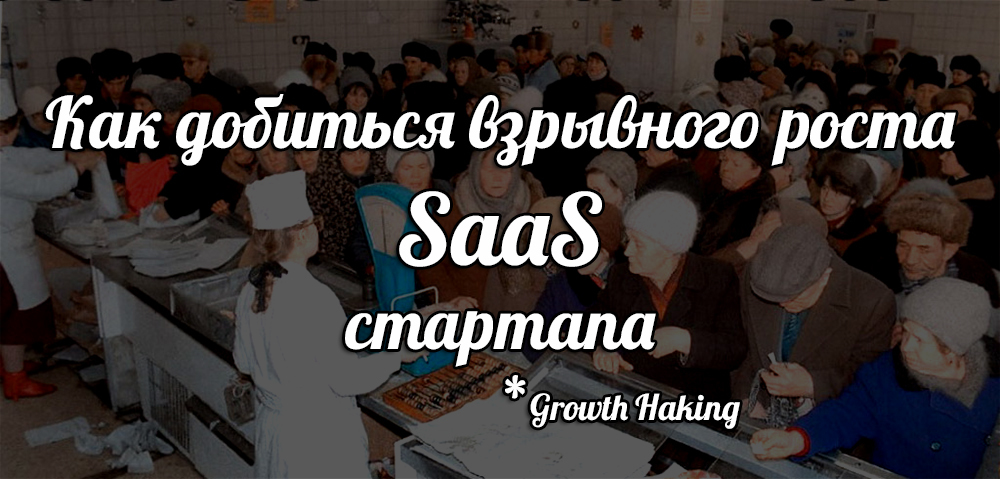How to achieve explosive growth SaaS-startup

In the first part of this topic, we examined new sales trends for SaaS companies. Now, it's time to take a look at some growth hacking techniques . Some of the examples below are based on successful projects that have grown from zero to more than a million users in a year. Obviously, in one article it is impossible to describe all the methods and examples of their implementation. Much of what is described is a rethinking of old marketing techniques such as retargeting, email marketing, adding social buttons to content, customizing and personalizing content, and much more. Let's take a closer look at some of them.
1. Tiny applications on large marketplaces
Previously, many or almost all startups dreamed of partnering with big names. They hired managers as vice-presidents, whose main job is not significant agreements were concluded with no known companies under the heading of Marketing Partnership Program ( "Marketing Partnership Program"). Often these comrades used to work for well-known companies. The result of such manipulations was the possibility of including a big name logo in slides for presentation to investors or customers. This practice was quite expensive and not very productive.
Today, huge costs can be avoided by placing the simplest application on one of the available application marketplaces, not to mention the App Store and Google Play. The Google Chrome app store, for example, is quite accessible to developers for any application running in the Chrome browser. Google Apps even more. The mobile version is even better. You will be pleasantly surprised when you see the morbidity of such a move. Be creative and develop a simple, quick and easy application with a good design, but with limited opportunities to capture your market niche, finish it later. Developed MVP (minimum viable product) and immediately into battle.
2. Freemium model
The popular and effective Freemium model, about which there is so much written, that sometimes you might think that all successful applications are built only on the basis of this model, can also be used for corporate SaaS. It is always possible and important to find the right amount of functions so that the client receives a product that works with restrictions. In this case, by controlling the free use of the platform by users and fine-tuning the volume of functionality, it is possible to achieve the necessary growth in paying users. The main thing here is not to overdo it and not to be greedy, otherwise either you will receive the wrong income that you could count on, or the user will leave. When it comes to attracting new customers, Freemium is by far the best model. With careful and meticulous customization of functionality, many users can choose the premium version.
3. Using marketing automation in the early stages
After traffic is generated by free accounts, you have the next step, which consists in scaling them to paying accounts. No need to wait for $ 1 million ARR (Annual Recurring Revenue) to automate marketing . You can use some simple but important materials, from answering machines and bots, to free training materials and case studies for new users. In general, the scope for imagination is quite wide.
4. Get personal assistants (concierge manager)
Automation is useful but has limitations and will never replace human communication. In this regard, there is no alternative to a personal assistant, the surprise of a new registered client from such a personalized approach will reward your costs with “word of mouth advertising” and crowds of new customers. For high-end products that meet the highest requirements, with a certain number of free registrations, this service can be offered to free users as well, which in itself can lead them to migrate to premium. But even if you have thousands of daily registrations of free accounts and a limited number of paying customers, the content of high-quality customer support will reduce the flow of customers and increase the number of upgrades to older versions of the product. This role can be played by both a distinguished person and a team,
"Do you remember how it all started?"
Are the above methods applied to startups in the early stages of development, while they are still busy designing and developing the product? In most startups, “sales people” are usually absent as a class, and it seems that these techniques are for startups at a later stage and large companies, right?
And no! If you think that you should think about sales after the first million ARRs, then miss out on cool opportunities. Remember, nothing will happen until there are sales. Of course, at the beginning it’s not worth recruiting two dozen people to the sales department, at least until the profitability of the methodology is confirmed. However, the sooner the integration of techniques occurs, the sooner you will get realistic and convincing results.
In conclusion, we consider the steps in the process of selling a SaaS product. Sale starts from the very first day of the product and goes through the following steps:
- MVP demo (based on a lean startup model), some also call this stage an MSP demo (Minimum Sellable Product).
- Customer feedback.
- Improved MVP and first money.
- The first three points with other customers.
- Automation of initialization of sales and the training process using marketing automation.
- Development of a free application for using incoming traffic from marketplaces.
- Domestic sales to close small deals to easily attract new customers.
- Upgrades of the product or up-sell, at the same time, account managers scale the sales department in accordance with the situation.
